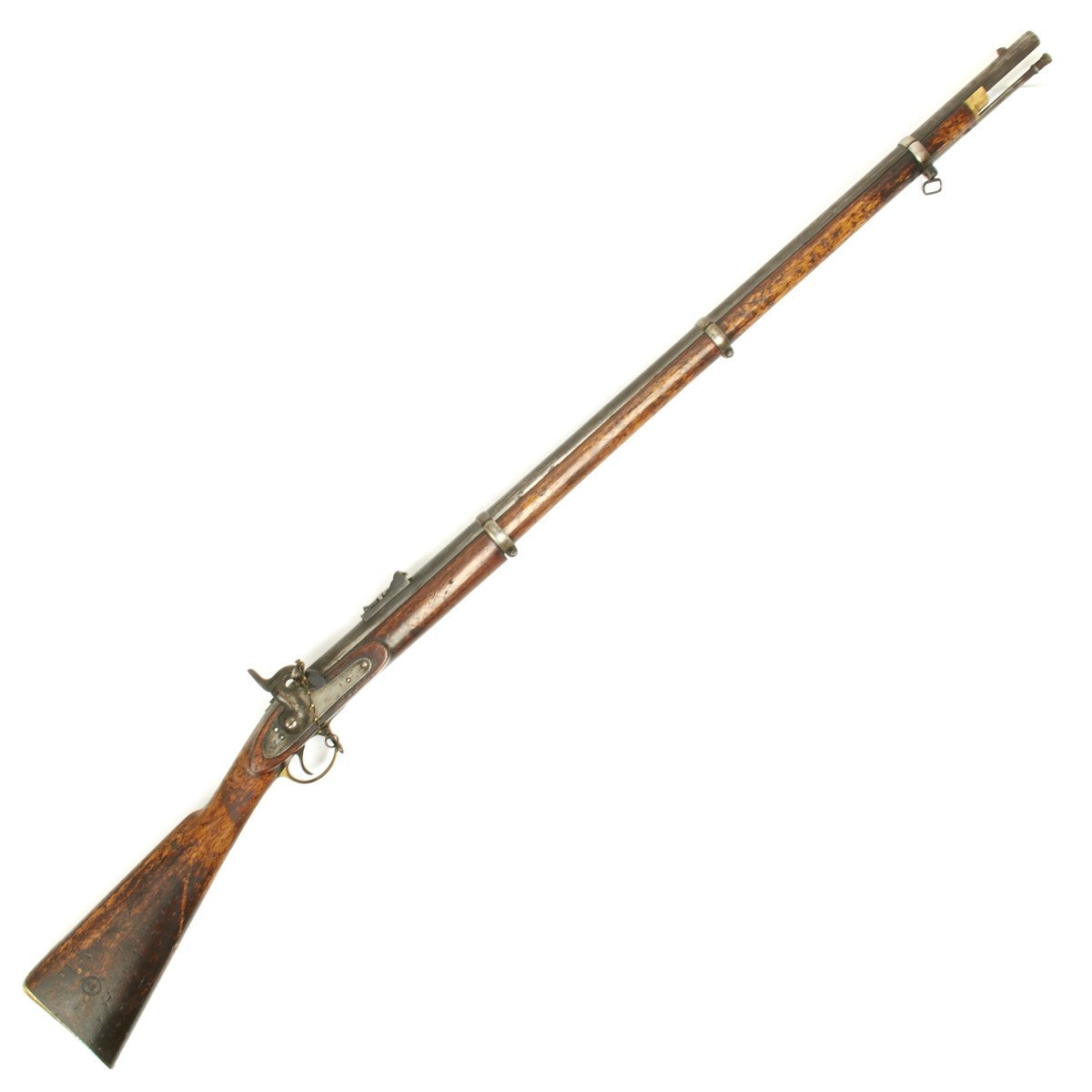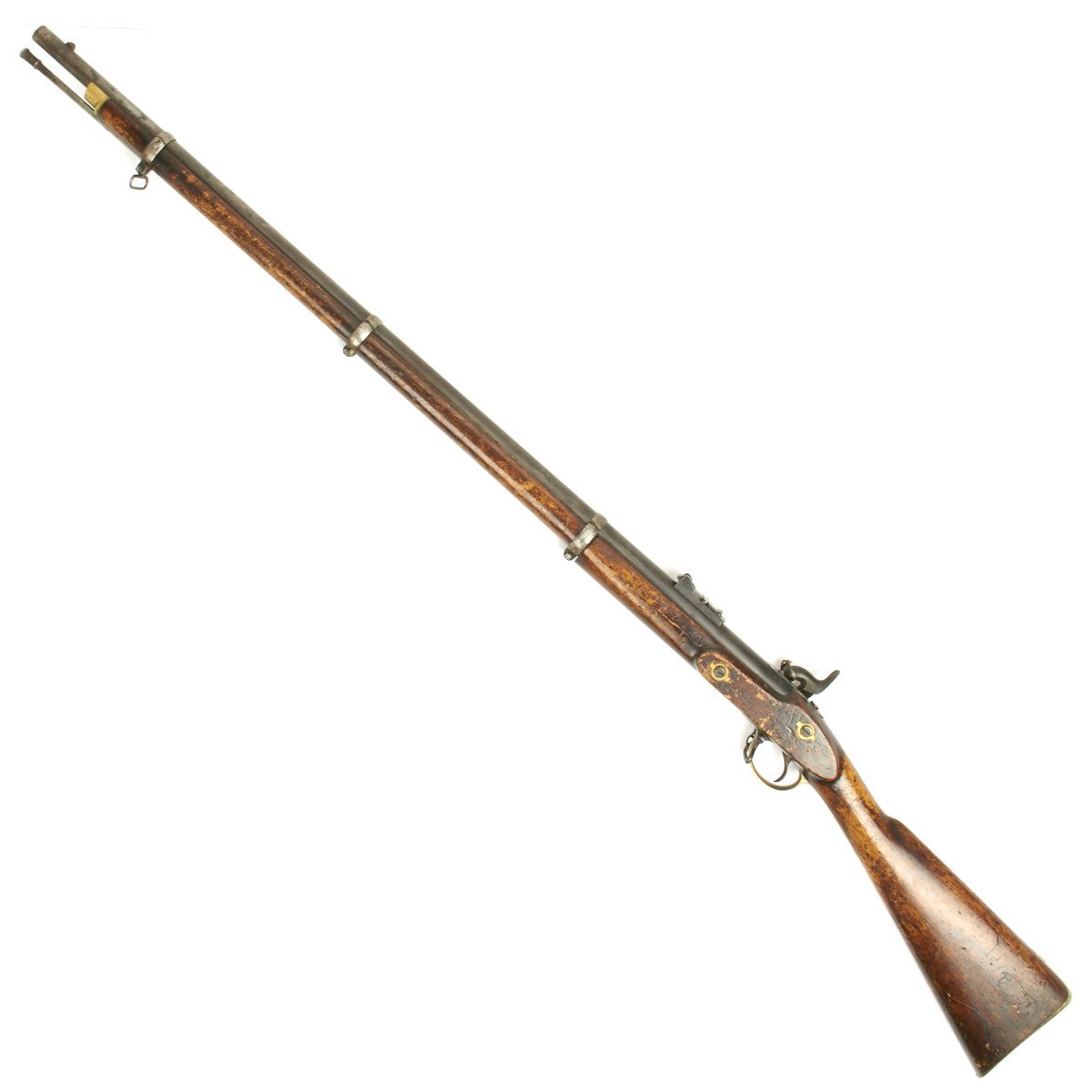Original British P-1853 Enfield Rifle Musket Produced in Belgium – Dated 1857 Original Items
$ 1.995,00 $ 498,75
Original Item: Only One Available. Offered here is a very nice example of the Pattern 1853 Enfield Rifle Musket as produced by the prolific gun trade in Liège, Belgium. The Liège gun trade had a long history of producing arms of previously established patterns to supplement the arms making capabilities of other nations. By the mid-19th century, the Liège arms trade had been producing gun parts to support the Birmingham & London gun trades for well over 100 years.
The Belgian makers were also the traditional source for additional British military arms during periods of need greater than could be accommodated by the London and Birmingham makers. With the advent of the Crimean War, the British Government turned to the Liège trade to supplement the manufacturing capabilities of their domestic gunmakers. The first Belgian contract for P-1853 Enfield Rifle Muskets was for 20,000 stands of arms. The contract commenced on October 31, 1854 and the arms were to be delivered by May 31 of the following year. With the ending of the war in February of 1856, the critical need for arms was temporarily alleviated, but the British War Department still let an additional contract for 5,000 more P-1853s from Liège in June of 1859. By the time the American Civil War erupted in April of 1861, the Belgian trade had several years of experience in the production of the most advanced and widely used muzzle loading military rifle musket in the world, and were tooled up to produce the pattern in quantity.
The Liège makers found a lucrative market for P-1853s with the American combatants. Many of the brokers who purchased thousands of continental arms for the US government, like Herman Boker & Co and James Hoey purchased Belgian made Enfields, along with arms from Austria, Prussia and France. While it is unclear how many Belgian made P-1853 rifle muskets were purchased by the combatants during the conflict, it is quite clear that many were. It is also quite clear that the British gun trade had long relied upon Belgian makers to supplement their output, and it is quite likely that a large number of the Enfields delivered on British contracts to the North and South included at least some Belgian made arms, and even more arms with Belgian made components. The makers of the Liège trade would often produce complete arms that were almost completely unmarked externally, allowing the purchaser to mark them as if they were their own product. This proclivity sometimes makes the recognition of Belgian produced arms somewhat difficult.
This Belgian made P-1853 Enfield Rifle Musket is a nice example of one of those Liège made weapons. The gun is in an very nice state of preservation and fully operational. The lock shows the typical double boarder line engraving found on most Birmingham and some London contractor produced Enfields, and is nicely marked with a CROWN over V.R. indicating it was from the 2nd contract to the British government. It is nicely dated 1857 on the lock plate.
The hammer is engraved with the typical feathers that one expects to find on Birmingham and some London made Enfields as well. The left side of the breech bears the typical Belgian Perron inspection mark, used to proof breeches from 1853 onward. The left side of the breech bears a typical 19th century Belgian definitive muzzle loading proof mark, the letters L in a large oval.
The barrel retains about 85%+ of its original blued finish, with some loss along high edges and the muzzle crown, and some tiny areas that show very minor fading. The bore of the musket is in equally very good condition, and is bright and shiny with excellent rifling. The lock and hammer both retain about 70%+ of their original case hardened coloring, but some minor fading to the vivid colors due to age.
The lock is crisp and is mechanically excellent, functioning perfectly on all positions. The gun is 100% complete, correct and original throughout. It retains its original long-range rear sight, the front site/bayonet lug and both of its sling swivels. The ramrod appears to be the original, period Enfield pattern rod that came with the gun. It is full length and retains threads on the reverse end. The bands are all matching and all retain their original screw keeper at the end of the tension screw, which prevents the screw from being completely removed from the barrel bands.
The stock of the gun is in nice condition as the metal, and the wood to metal fit is outstanding throughout. The stock has never been sanded and retains edges and lines. The stock shows only a very few minor bumps and dings from handling and storage. The stock is complete, solid and free of any breaks, cracks or repairs. There is a clear cartouche with British broad arrow and 1858 date, again certifying this was from the second contract ordered by the British government. The butt plate has markings that read:
I.C.
594
These markings are very interesting. There were several Confederate buyers with whom the British government would not sell to having already settled contracts with the Union side. One active company buying for the Confederate States was SINCLAIR HAMILTON & COMPANY who employed an English “Viewer/Inspector” to check weapons before purchase on their behalf. This inspectors name was ISAAC CURTIS. The “I.C. 594 is curious as 594 is too great a number to be a rack number and I.C. does not translate to a known British regiment so perhaps it is the mark of “ISAAC CURTIS” who executed weapon inspections on behalf of the Confederate arms suppliers “SINCLAIR HAMILTON & COMPANY? We may never know, but worth of further research.
Overall this is a wonderful as issued condition example of a commercial Belgian manufactured P-1853 Enfield Rifle Musket, destined for use by the British military. Possibly later this gun was sold to fill a northern or southern Civil War contract but it is impossible to know.
Every collection of P-1853 Enfields needs to have at least one Belgian contract made musket in it. This gun is a fine example, and will be a real centerpiece in an advanced collection of high condition Civil War era long arms.
Specifications:
Years of Manufacture: 1857
Caliber: .58 inches
Ammunition Type: .577 Lead Ball & Powder with Percussion Cap
Overall Length: 55 inches
Action: Percussion Lock
Feed System: Muzzle-Loaded
NOTE: International orders of antique firearms MUST be shipped using UPS WW Services (courier). USPS Priority Mail international will not accept these. International customers should always consult their country’s antique gun laws prior to ordering.
Fast Shipping with Professional Packaging
Thanks to our longstanding association with UPS FedEx DHL, and other major international carriers, we are able to provide a range of shipping options. Our warehouse staff is expertly trained and will wrap your products according to our exact and precise specifications. Prior to shipping, your goods will be thoroughly examined and securely secured. We ship to thousands clients each day across multiple countries. This shows how we're dedicated to be the largest retailer on the internet. Warehouses and distribution centres can be located throughout Europe as well as the USA.
Note: Orders with more than one item will be assigned a processing date depending on the item.
Before shipping before shipping, we'll conduct a thorough inspection of the items you have ordered. Today, the majority of orders will be delivered within 48 hours. The delivery time will be between 3-7 days.
Returns
The stock is dynamic and we cannot completely manage it because multiple stakeholders are involved, including our factory and warehouse. So the actual stock may alter at any time. It's possible that you may not receive your order once the order has been made.
Our policy is valid for a period of 30 days. If you don't receive the product within 30 days, we are not able to issue a refund or an exchange.
You can only return an item if it is unused and in the same state as the day you received it. You must have the item in its original packaging.
Related products
Uncategorized
Uncategorized
Uncategorized
Uncategorized
Australian WWII Owen MK1 Machine Carbine SMG Custom Fabricated Replica with Sling Original Items
Uncategorized
Uncategorized
Uncategorized
Uncategorized
Uncategorized
Angolan Rebel 1970s era 60mm Inert Display Mortar from Angolan Civil War Original Items
Uncategorized
Uncategorized
Uncategorized
Uncategorized
Uncategorized
Uncategorized
Uncategorized
Uncategorized
Uncategorized
Armoured Fighting Vehicles of the World: AFVs of World War One (Hardcover Book) New Made Items












































































